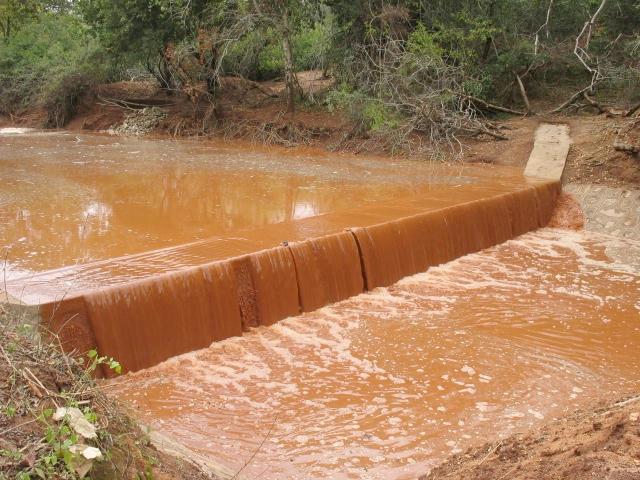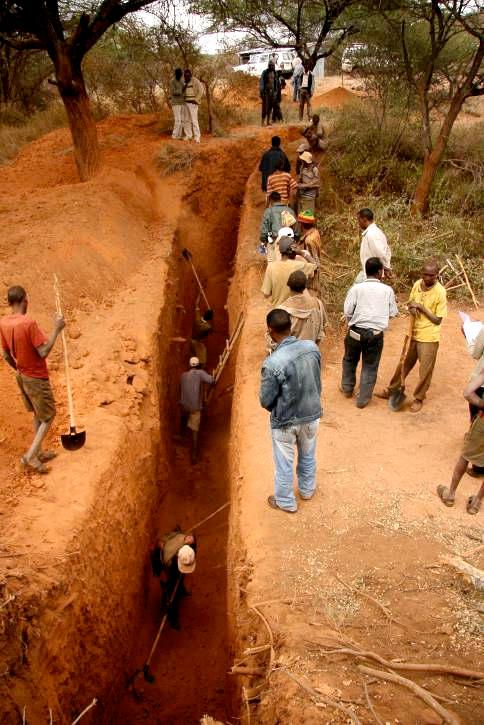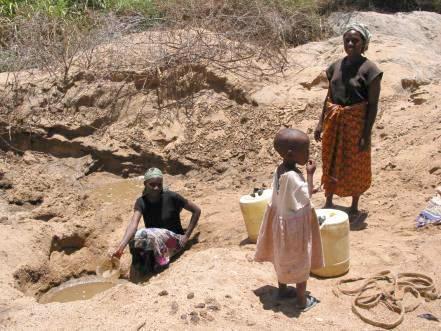Difference between revisions of "Water Portal / Rainwater Harvesting / Groundwater recharge / Sand dam"
(→Suitable conditions) |
(→Suitable conditions) |
||
| Line 32: | Line 32: | ||
- Regeneration of vegetation along riverbanks <br> | - Regeneration of vegetation along riverbanks <br> | ||
- Sand dam effects on downstream river discharge are generally small (< 10% of runoff). <br> | - Sand dam effects on downstream river discharge are generally small (< 10% of runoff). <br> | ||
| − | - Better water quality than surface water dams: | + | - Better water quality than surface water dams: protects the water against evaporation, animal contamination and insect & bacteria breeding. <br> |
- Sand deposits can be collected and sold for extra income. <br> | - Sand deposits can be collected and sold for extra income. <br> | ||
- Long lifespan if maintained correctly. | - Long lifespan if maintained correctly. | ||
Revision as of 21:57, 30 March 2012
Regions with highly erratic rainfall often have rivers with temporary seasonal sandy bed streams. They only experience heavy water run-off for short periods of time after rain. During such periods of high flows, large quantities of sand are transported downstream. Some sand can get trapped on the upstream sides of rock outcroppings along the stream. The sand traps form natural water storing aquifers. Sand dam technology provides a means to reproduce this water collecting mechanism and to increase the size of existing aquifers.
Water in natural collection sites is usually clean for drinking but limited and quickly gets depleted. Sand dams are an artificial improvement of sand beds where more water can be recharged and stored for water use. A dam of concrete, clay soil or stone masonry is constructed across the channel at specific sites to trap and hold back the sand during flooding; this creates an additional sub surface water bank to be harvested during the dry season.
With an accurate and appropriate location choice the total amount of water available in the sand dams can be over 6000m³.
Sand dam projects here have not only improved water availability, but benefited the community socially and economically. Locals are trained to participate in construction of the dam, maintenance, financial management, and also in natural resource management.
Suitable conditions
Expert input is required to determine the best site for the dam and to make sure the project is adapted to the physical conditions as well as social circumstances of the local community. Physically, the site must be suitable for construction of a dam, provide safe drinking water, and be able to use sand sedimentation to increase water availability. Firstly it must be decided if the river is appropriate, secondly the best section of riverbed must be chosen, and then the optimum location for extraction.
Generally, the dam requires a sandy riverbed in a hilly area. Preferably the riverbed consists of coarse sands laid on impermeable bedrock. The river should be seasonal but must have a base flow. Whether this is the case can be determined by the type of vegetation growing around the river. The river shouldn’t be too wide (max. 25m) and should have two high riverbanks.
These conditions and also others related to, for example; climate, presence of boulders, or gradient of the riverbed must be analyzed in detail to determine suitability of the site. Also, though it can be artificially improved, the water quality must be good enough for drinking (not too saline, contaminated, etc.)
| Advantages | Disadvantages |
|---|---|
|
- Year-round source of good quality water |
- External expert knowledge needed |
Construction, operations and maintenance
First a trench needs to be dug. Its position is marked out using pegs. Then it is excavated and the soil placed downstream. It can also be dug out into bedrock. It should then be checked for weathering zones and cracks.
Round bars are placed vertically along the trench to reinforce it. Then a foundation is laid consisting of 2 layers of cement with barbed wire in between. Once this has set, the trench is filled with masonry of mortar and hardcore. The wing walls and final dam wall can then be constructed. Finally any exposed parts of the construction are plastered.
Building the sand dam (and wing wall)
- The method depends on the type of dam and the type of ground. The construction of sand dams in cascades improves total storage and efficiency and minimizes seepage losses. Dams made of concrete, stone-masonry and brickwork require skilled labour for construction, but are stronger and have a longer lifespan.
- Key into banks (sub-surface dams) or construct wing walls to avoid erosion around edges of the sand dam. Where wing walls are built, a good technique is to start from the wing walls and work inwards to the centre, since community enthusiasm lags by the time wing walls are constructed (if not built first), yet they are essential to proper functioning. Length of the wing wall varies according to bank characteristic: loose riverbanks, 7 metres; hard soils, 5 metres; hard & impermeable soils or rocks, wing wall is not needed. Planting napier grass along upstream riverbanks controls erosion and fixes the course of the river in a flood.
- The height of wall built before each flood event should not exceed accumulation rate of coarse to medium sand during that flood event, otherwise ponding & silt deposition will occur, which can lower specific yield and higher capillarity, then lead to limited extraction rates in wells upstream and more water lost to evaporation. Dams at 1.3m depth showed that where finer material content (0.063 mm or less) is increased, specific yield is known to decrease remarkably. Accumulation rate and therefore height varies according to location and should be adjusted at each site after the first flood event demonstrates the rate of accumulation. Height per stage will probably be between 0.3 metre and 1 metre per stage according to experience from past projects. Some silt deposition will always occur as velocities decrease toward the end of the flood event; the idea is to limit its quantity in final sand volume.
- In upstream parts of a catchment it is recommended that sand dams are always built in stages, since the availability of coarse material is generally limited and base flow is small or absent (base flow = sub-surface flow which aids surface flow so that silt/clay can still be flushed away once rainfall stops, rather than sinking directly into the sand bed). It has also been suggested that to build in stages over several years is also more beneficial for functioning of dam committees. Build them within a spillway, which was part of the first stage & wing wall construction.
After the dam is built, an outlet for water extraction must be constructed. Hand dug scoop holes are the simplest possibility, however the water can easily be contaminated. Covered wells, with hand or rope pumps protect the water much better. It is also possible to construct an outlet pipe with a tap. This however is difficult to maintain, and can weaken the dam. Meanwhile the local community needs to be trained to manage and maintain the dam.
First an appropriate site needs to be selected, depending on whether it is suitable for a sand dam or not. Then the best section of the riverbed is chosen. Then the dam is designed, depending on the conditions and the water needs of the community, and built. After that an extraction point is constructed such as a scoop hole or well. Then water can be extracted and used for drinking, agriculture, etc.
Maintenance
If done timely, the maintenance required is not costly. Small malfunctions in the dam however can lead to destruction of the entire dam. Therefore, the dam should be regularly checked for cracks and damage. Particularly after floods, and extreme temperature changes cracks are likely. These need to be repaired as soon as possible by a trained mason.
Further the outlet and upstream riverbed should be cleaned regularly to make sure the dam does not get blocked. Silt, rocks, dead animals, etc. should be removed regularly. This can also help prevent contamination of the water. The quality of the water in the well should be checked once in a while by an expert.
Estimated Lifespan
The lifespan depends on the materials used and expertise with which it is constructed and maintained. The dams in Kitui Kenya were built at a cost of 7500 USD and have a minimum lifespan of 50 years.
Costs
The construction of dams is largely carried out by the local community. Costs mainly relate to local availability of cement, masonry and professional supervision.
Cost of introduction:
- Material: US$ 5,500
- Other costs: US$ 500
- Labour: - skilled: US$ 2,500 - unskilled: 900 man days -
Cost of maintainance:
- Operation and maintenance: 5 days per year
Case studies
In Kenya, it has been used with good outcome in the Kitui, Machakos and Samburu districts. Other countries with similar dry environments such as the U.S.A, Thailand, Ethiopia and Namibia also have used it in numerous and diverse forms.
Kitui district, Kenya: SASOL Foundation has since 1995 built over 500 dams. They are built using locally available materials and are partially (40%) financed by the local community. The community is also involved in the construction and maintenance. Sand management groups were formed to aid in the construction of dams and to maintain them after.
The dams not only provide a steady source of drinking water, but also have further social and economic benefits. They provide irrigation for cash crops and other commercial rural activities, piped water for industrial activities in nearby villages. Further due to the large number of dams, the water table rises over a large area and therefore stimulates ecological regeneration.
Borana Zone, Ethiopia: Communities in this area depend on agriculture and livestock farming, which is very limited due to the unstable water supply. In 2007 several NGOs implemented 7 sand dams and 10 surface runoff tanks. This combination should provide a reliable source of water for 10 communities in the area. The project will in the future expand to other parts of the country also.
Reference manuals, videos, and links
- Manual: A practical guide to sand dam implementation. Rainwater Harvesting Implementation Network (RAIN).
- Video: Kitui Sand Dams - CPWC
- Video: RAIN sand dam workshop & field visit in Ethiopia, 2009, by RAIN foundation and EHRA.
- Video: Sand dam movie - Excellent Development.com
- www.sanddam.org - All information on sand dams
- Sasol Project Kenya
- ACACIA Water
- UNEP
- IAH
- Water for Arid Land
- Practical action
- Excellent Development






